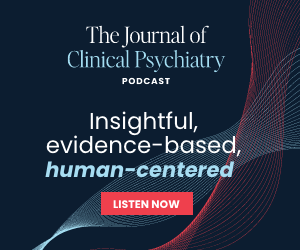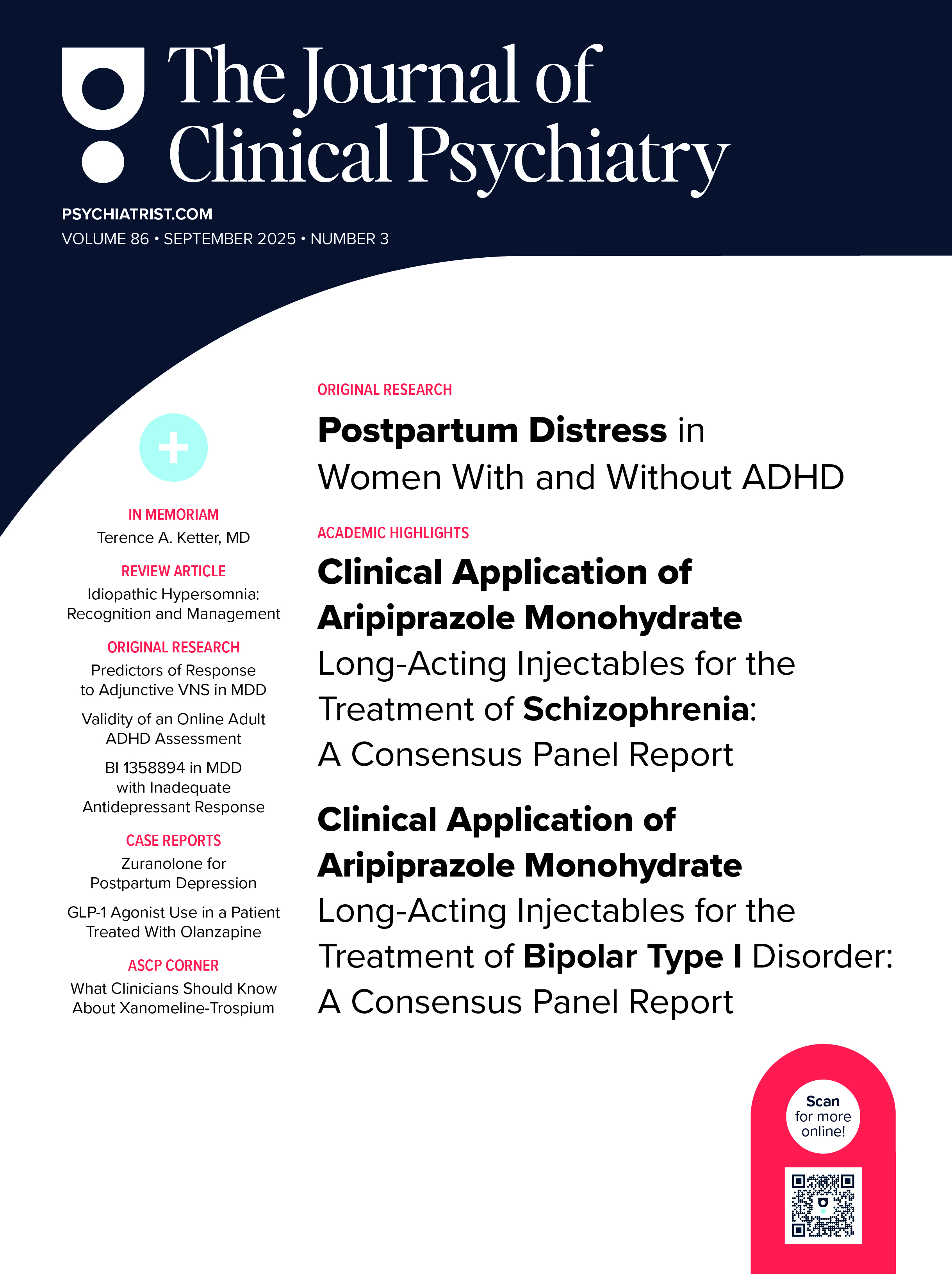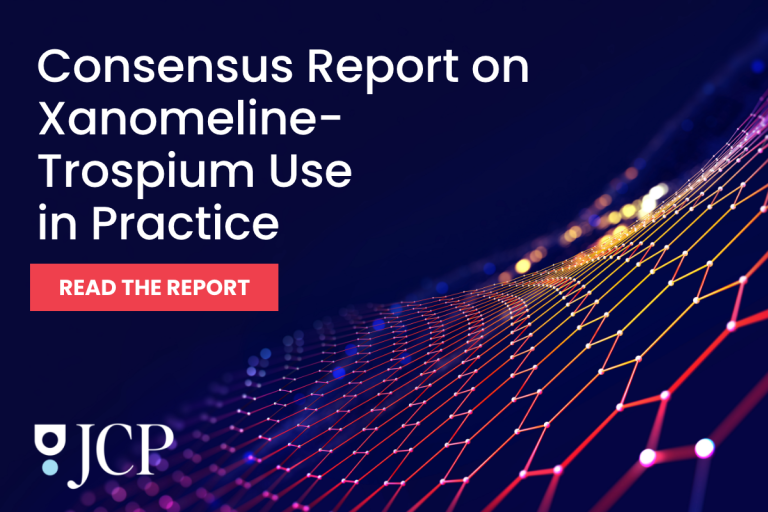ABSTRACT
Objective: Psychiatric disorders are an established risk factor for divorce or separation. Despite the fact that 10%–15% of new mothers experience postpartum psychiatric episodes (PPEs), no previous studies have investigated the effects of PPEs on the probability of divorce in these new families. Therefore, this study aimed to investigate and quantify the probability of subsequent divorce/separation among women with either mild/moderate or severe PPE compared to mothers without PPE.
Methods: This cohort study based on the national Danish registers included all cohabitating, primiparous women without previous psychiatric history who gave birth from 1996 through 2014. At 6 months postpartum, each woman’s PPE status was evaluated and categorized as follows: (1) mild/moderate PPE (prescription of psychotropic medication—Anatomical Therapeutic Chemical Classification codes N03–N07), (2) severe PPE (psychiatric inpatient or outpatient treatment—International Classification of Disease, 10th Edition codes F00–F99, excluding codes for organic mental disorders, substance abuse, and mental retardation), and (3) no PPE (reference group). Subsequently, the status of cohabitation was assessed a maximum of 5 times (every January 1).
Results: A total of 266,771 new mothers were included; 4,442 had a first mild/moderate PPE and 1,141 had a first severe PPE within 6 months postpartum. Compared to mothers without PPE, women with mild/moderate PPE had a significantly higher probability of later divorce (adjusted hazard ratio [HR] = 1.23; 95% CI, 1.15–1.31); for women with severe PPE, the probability was even greater (adjusted HR = 1.64; 95% CI, 1.45–1.85).
Conclusions: Women experiencing their first-ever PPE following childbirth have a higher probability of divorce in the years following their diagnosis than mothers without PPE. Further, this study showed a dose-response relationship between the severity of PPE and the probability of divorce.
Members Only Content
This full article is available exclusively to Professional tier members. Subscribe now to unlock the HTML version and gain unlimited access to our entire library plus all PDFs. If you’re already a subscriber, please log in below to continue reading.
References (34)

- Meltzer-Brody S, Howard LM, Bergink V, et al. Postpartum psychiatric disorders. Nat Rev Dis Primers. 2018;4(1):18022. PubMed CrossRef NLM
- Munk-Olsen T, Maegbaek ML, Johannsen BM, et al. Perinatal psychiatric episodes: a population-based study on treatment incidence and prevalence. Transl Psychiatry. 2016;6(10):e919. PubMed CrossRef NLM
- Wisner KL, Sit DK, McShea MC, et al. Onset timing, thoughts of self-harm, and diagnoses in postpartum women with screen-positive depression findings. JAMA Psychiatry. 2013;70(5):490–498. PubMed CrossRef NLM
- Howard LM, Molyneaux E, Dennis CL, et al. Non-psychotic mental disorders in the perinatal period. Lancet. 2014;384(9956):1775–1788. PubMed CrossRef PubMed CrossRef NLM
- Jones I, Chandra PS, Dazzan P, et al. Bipolar disorder, affective psychosis, and schizophrenia in pregnancy and the post-partum period. Lancet. 2014;384(9956):1789–1799. PubMed CrossRef NLM
- Leopold T. Gender differences in the consequences of divorce: a study of multiple outcomes. Demography. 2018;55(3):769–797. PubMed CrossRef NLM
- Sbarra DA. Divorce and health: current trends and future directions. Psychosom Med. 2015;77(3):227–236. PubMed CrossRef NLM
- Lamela D, Figueiredo B, Bastos A, et al. Typologies of post-divorce coparenting and parental well-being, parenting quality and children’s psychological adjustment. Child Psychiatry Hum Dev. 2016;47(5):716–728. PubMed CrossRef PubMed CrossRef NLM
- Sands A, Thompson EJ, Gaysina D. Long-term influences of parental divorce on offspring affective disorders: a systematic review and meta-analysis. J Affect Disord. 2017;218:105–114. PubMed CrossRef NLM
- Robbers S, van Oort F, Huizink A, et al. Childhood problem behavior and parental divorce: evidence for gene-environment interaction. Soc Psychiatry Psychiatr Epidemiol. 2012;47(10):1539–1548. PubMed CrossRef NLM
- Befolkningens udvikling 2018. Danmarks Statistik. October 2019. Accessed February 3, 2020. https://www.dst.dk/Site/Dst/Udgivelser/GetPubFile.aspx?id=29443&sid=befudv2018
- Røsand GM, Slinning K, Røysamb E, et al. Relationship dissatisfaction and other risk factors for future relationship dissolution: a population-based study of 18,523 couples. Soc Psychiatry Psychiatr Epidemiol. 2014;49(1):109–119. PubMed CrossRef NLM
- Breslau J, Miller E, Jin R, et al. A multinational study of mental disorders, marriage, and divorce. Acta Psychiatr Scand. 2011;124(6):474–486. PubMed CrossRef NLM
- Małus A, Szyluk J, Galińska-Skok B, et al. Incidence of postpartum depression and couple relationship quality [in Polish]. Psychiatr Pol. 2016;50(6):1135–1146. PubMed CrossRef NLM
- Mamun AA, Clavarino AM, Najman JM, et al. Maternal depression and the quality of marital relationship: a 14-year prospective study. J Womens Health (Larchmt). 2009;18(12):2023–2031. PubMed CrossRef NLM
- Cox JL, Connor Y, Kendell RE. Prospective study of the psychiatric disorders of childbirth. Br J Psychiatry. 1982;140(2):111–117. PubMed CrossRef NLM
- Blackmore ER, Rubinow DR, O’Connor TG, et al. Reproductive outcomes and risk of subsequent illness in women diagnosed with postpartum psychosis. Bipolar Disord. 2013;15(4):394–404. PubMed CrossRef NLM
- Pedersen CB. The Danish Civil Registration System. Scand J Public Health. 2011;39(7 suppl):22–25. PubMed CrossRef NLM
- Kildemoes HW, Sørensen HT, Hallas J. The Danish National Prescription Registry. Scand J Public Health. 2011;39(7 suppl):38–41. PubMed CrossRef NLM
- Mors O, Perto GP, Mortensen PB. The Danish Psychiatric Central Research Register. Scand J Public Health. 2011;39(7 suppl):54–57. PubMed CrossRef NLM
- The Population Statistics Register. The National Centre for Register-based Research, Department of Economics and Business Economics. 2020. Updated January 1, 2020. Accessed April 30, 2020. https://econ.au.dk/the-national-centre-for-register-based-research/danish-registers/the-population-statistics-register/
- Jensen VM, Rasmussen AW. Danish Education Registers. Scand J Public Health. 2011;39(7 suppl):91–94. PubMed CrossRef NLM
- Børn og deres familier 2018. Danmarks Statistik. 2018. Accessed February 5, 2020. https://dst.dk/Site/Dst/Udgivelser/GetPubFile.aspx?id=31407&sid=bornfam2018
- Andersson G. The impact of children on divorce risks of Swedish women. Eur J Popul. 1997;13(2):109–145. PubMed CrossRef NLM
- Idstad M, Torvik FA, Borren I, et al. Mental distress predicts divorce over 16 years: the HUNT study. BMC Public Health. 2015;15(1):320. PubMed CrossRef NLM
- Liu X, Plana-Ripoll O, Ingstrup KG, et al. Postpartum psychiatric disorders and subsequent live birth: a population-based cohort study in Denmark. Hum Reprod. 2020;35(4):958–967. PubMed CrossRef NLM
- Johannsen BM, Larsen JT, Laursen TM, et al. Self-harm in women with postpartum mental disorders. Psychol Med. 2020;50(9):1563–1569. PubMed CrossRef NLM
- Lindahl V, Pearson JL, Colpe L. Prevalence of suicidality during pregnancy and the postpartum. Arch Women Ment Health. 2005;8(2):77–87. PubMed CrossRef NLM
- Appleby L, Turnbull G. Parasuicide in the first postnatal year. Psychol Med. 1995;25(5):1087–1090. PubMed CrossRef NLM
- Munk-Olsen T, Ingstrup KG, Johannsen BM, et al. Population-based assessment of the recurrence risk of postpartum mental disorders: will it happen again? JAMA Psychiatry. 2020;77(2):213–214. PubMed CrossRef NLM
- Munk-Olsen T, Laursen TM, Meltzer-Brody S, et al. Psychiatric disorders with postpartum onset: possible early manifestations of bipolar affective disorders. Arch Gen Psychiatry. 2012;69(4):428–434. PubMed CrossRef NLM
- Johannsen BM, Larsen JT, Laursen TM, et al. All-cause mortality in women with severe postpartum psychiatric disorders. Am J Psychiatry. 2016;173(6):635–642. PubMed CrossRef NLM
- Appleby L, Mortensen PB, Faragher EB. Suicide and other causes of mortality after post-partum psychiatric admission. Br J Psychiatry. 1998;173(3):209–211. PubMed CrossRef NLM
- Nilsen SA, Breivik K, Wold B, et al. Divorce and adolescent academic achievement: heterogeneity in the associations by parental education. PLoS One. 2020;15(3):e0229183. PubMed CrossRef NLM





